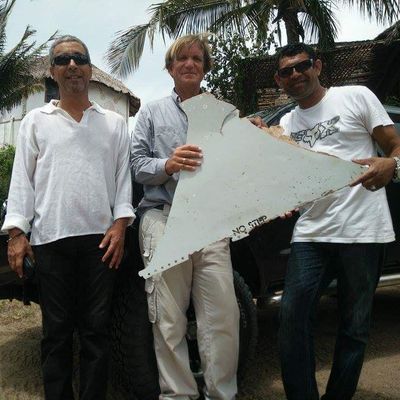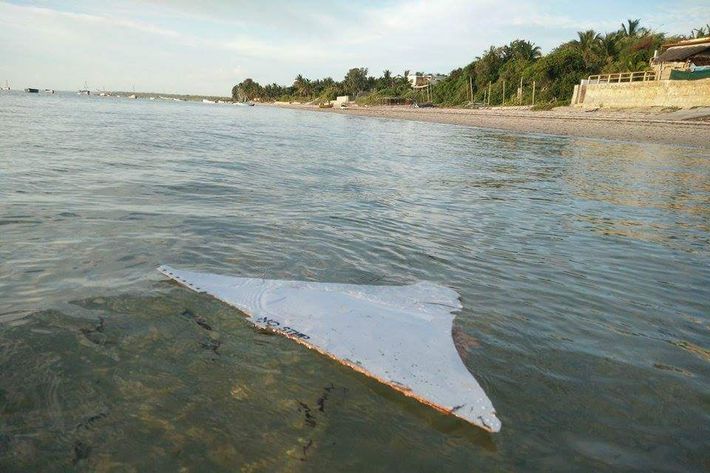
Blaine Alan Gibson, a 58-year-old lawyer who lives in Seattle, Washington, has spent much of the past year traveling around the Indian Ocean region trying to solve the mystery of what happened to Malaysian Airlines Flight 370. He’s been to the Maldives to talk to villagers who say they saw a large plane fly low overhead the day after the disappearance; visited Réunion Island to interview the local who found the flaperon from MH370; and met with Australian deputy prime minister Warren Truss to discuss the ongoing seabed search. He has no professional background in aircraft-accident investigation or journalism, and no professional accreditation. He is simply motivated by the desire to know what happened to the airliner. “I do not have a theory,” he emailed me last September. “I am just looking for evidence that may have been prematurely dismissed.”
Last week, Gibson found himself in Mozambique searching for debris on local beaches. On February 27, he says, he hired a boat captain to take him someplace where flotsam from the ocean tended to wash up. The captain chose a sandbar called Paluma, a half-dozen miles from the coastal town of Vilankulos. They arrived at around 7 a.m., and after about 20 minutes on the flat, low stretch of sand the boat captain spotted something unusual and handed it to Gibson.
The next morning, Gibson emailed me a description of the object:
The debris appears to be made of a fiberglass composite and has aluminum honeycomb inside. NO STEP is written on one side. It appears to be from an aircraft wing … The piece is torn and broken into a triangular shape, 94 cm long at the base and 60 cm high. The remaining highlock pin has a 10 mm diameter head. The pin itself is about 12 mm long. The bolt holes are spaced about 30 mm apart from center to center of hole. The distance from the edge of the hole with the pin to the intact edge is about 8 mm. At the bottom of the intact edge there is a very thin (1 to 2 mm thick) strip of dried rubber remaining that runs about 30 mm along the edge before it was broken off. The intact edge is only 65 mm long. All the rest is broken.
In a video that Gibson posted to a closed-access Facebook page, the fragment looks quite light and insubstantial, easy enough for one man to pick up and wave around — unlike the flaperon found on Réunion, which required several people to lift. Gibson asked me to keep his find a secret, explaining, “It is too large and metallic to be easily taken out of the country, and needs to have its provenance documented. The procedure with other possible debris discoveries in La Réunion, Thailand, Vietnam, and Malaysia has been to report it to local authorities first. Then the responsible international investigators can come to inspect.”
On Tuesday, Gibson bundled up the piece in cardboard and flew with it to Maputo, the capital of Mozambique, to turn it over to the authorities. Wednesday morning, news articles about the discovery appeared on CNN, the BBC, NBC, and elsewhere. According to these accounts, experts believe that the piece could be part of the composite skin from the horizontal stabilizer — that is, one of the miniature “wings” on either side of the tail — of a 777. And, of course, no other 777 has been lost in the Indian Ocean except for MH370.
On Wednesday afternoon, I managed to reach Gibson by phone in Maputo. He sounded tired but elated, having just gotten off a live interview on Richard Quest’s show on CNN. “I did not expect that this would all hit this early and so fast,” he said. He told me that he and the Australian consul had met earlier that day with the head of civil aviation in Mozambique, who promised that he would do the proper paperwork and then turn the piece over to the Australian Transportation Safety Board, who are overseeing the search for MH370 in the southern Indian Ocean. “It’s in very good hands,” he said.
When he first held the piece, he told me, his immediate reaction was that it was so light and thin, that it was probably from some light aircraft or small plane — “but maybe it’s from MH370.” Only when back on dry land and able to consult with other MH370 researchers did he realize that the lettering looks identical to the “NO STEP” warnings on the wings of 777s, and the alphanumerical code on the head of a rivet indicates that it’s a fastener used in the aerospace industry.

To verify that the part could indeed have floated its way naturally to the beach, he had put it in the ocean and photographed it floating “just absolutely flat as a pancake” at the surface. He was struck by the absence of marine life. “There were a few little things that looked like a little bit of algae or calcification that may have come from something that tried to attach there,” he says. “But the top surface with NO STEP on it was very smooth, and the bottom was a little rougher but still pretty smooth.”
He knows that sounds odd: After two years in the ocean, a piece of floating debris should be encrusted with growth. But having spent the last year steeped in the oddness of the case, he’s learned to expect the unexpected. “I’m open to anything,” he says. Even the timing of the discovery was eyebrow-raising: just a few days before the second anniversary of the MH370’s disappearance.
The yearlong plunge into the case is just the latest rabbit hole for the California-bred Gibson, who is fluent in six languages. In the past, he has traveled to remote Siberia to investigate the Tunguska meteor, to Central America to figure out why the Maya disappeared, and to Ethiopia in search of the Lost Ark. So he knows not only about unraveling weird mysteries, but also the skepticism that such efforts can engender. “I can tell you this about that piece: it is absolutely authentically there,” he says. “There is no way that that was planted there by any shenanigans. I rode with those guys on the boat there, and they didn’t carry anything there. It was a completely natural find. It was just freak luck or destiny, whatever you want to call it.”






























